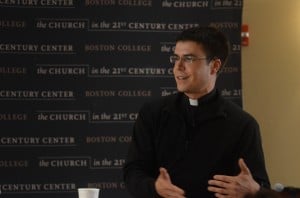Is there a real relationship between faith and technology, or is it just a matter of one using the other? Is the Church’s task with respect to the internet just to learn how to get its message out, or do we actually have something to learn from it? And do we have anything to offer back about technology, beyond moralizing about its proper use? Can we go beyond talking about how to use technology to talking about what it is really for?
Here’s a potential answer to these questions: a beautiful video of Carmelites from around the world singing St. Teresa of Avila’s “Nada te turbe” prayer (thanks to The Anchoress for the link).
They’re singing from all around the world, recording sound and video on their computers, which has then been edited together into a single “virtual choir.”
While we don’t sound anywhere near as angelic, the visual reminded me of the way we run meetings for The Jesuit Post, an operation that in total (most of them writing for our main site) involves more than 50 Jesuits, with at least five of us in most editorial meetings: Google Hangouts with little panes of video from which we’re doing our apostolic planning. An older Jesuit once asked me where The Jesuit Post was headquartered. After a moment of stunned silence, I answered, “Mountain View, I guess. That’s where Google is.”
But the real answer, of course, is that we are headquartered “in the cloud.” We’re all over the place, and classical Jesuit mobility (“our home is the road,” as one of our earliest self-descriptions had it) has taken on a whole new dimension.
Carmelites, on the other hand, don’t do mobility — but they do prayer, and the community of prayer has always transcended geography. I think anyone who has ever joined a monastic community at prayer has felt something of that truth: their prayer, wherever and whenever it is, is also part of the liturgy of heaven, and they pray in and with and for the whole Church.
The brilliance of this video is that it incarnates that reality and makes it more readily imaginable for people who may never get near a monastic community but for whom YouTube is only a click away.
And I do mean incarnates. This puts flesh on (part of) what we mean when we say we are surrounded by “so great a cloud of witnesses”; it gives us a chance to imagine anew what being bound up in a communion that encompasses all of time and history means. Which means that technology can be an authentic gift to the Church as a place within which we can continue to uncover the depths of what we believe.
And at the same time, I think the Church can and should reciprocate the gift. Benedict XVI spoke of the need for the humanization of media, and of the mission of evangelizers to help “give a soul” to communication on the internet. Or, as I clumsily translate that insight, with as significant a human achievement as the internet, we ought to be able to do something better than another kitten video. It’s already a great technological accomplishment, but the internet is still in the process of becoming a great human endeavor. The Church has always been part of the development of the arts and other forms of communication into their full potential, and we should be here as well.
We see hints of this potential all around us, if we know how to look. When something like an Apple commercial resonates, it’s not just because it’s excellently produced (though we should learn from their production values too). It’s because it presents something worthy of desire. That’s not just marketing: it’s actually a kind of evangelization, or at least pre-evangelization, and it succeeds so well because it echoes our natural desires and (partially) shapes them in the way they are designed and meant to grow.
As I’ve said before, even if that kind of insight can be a starting place, it does not go far enough. But it can be a starting place — and building on it, not only can a “virtual” choir teach us something quite real about the meaning of prayer and communion, but perhaps the Church can offer back, as a gift to technology and its users, a glimpse of the realities at which our desires ultimately aim.
What exactly that might look like, I don’t yet know. And though I’m certain that prayer is necessary, I doubt what we can offer is as simple as digitizing monks and nuns at prayer. Whatever it is, it will require humble enough imaginations to recognize that we believers have something to learn here, not only about how to use technology, but even more about how God works with us when we’re using it.
With that hope, then, I’ll leave you with the Carmelites again, this time singing “Salve Regina.”















